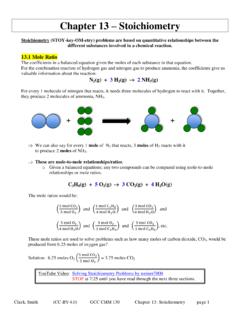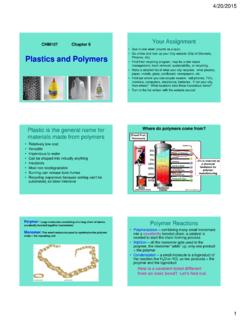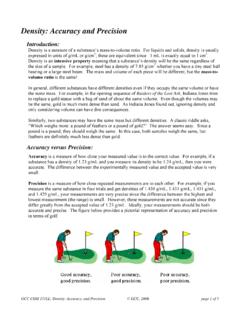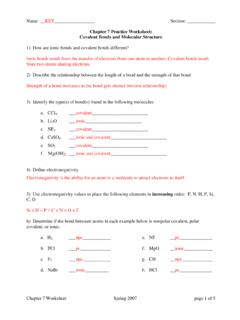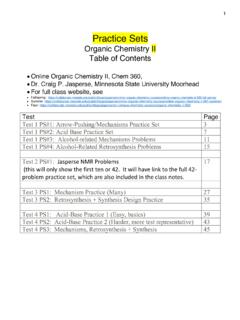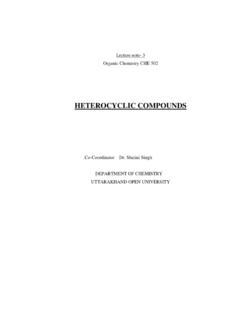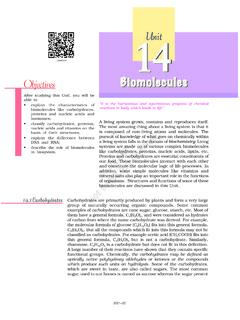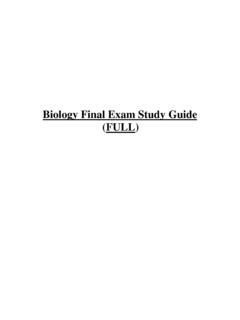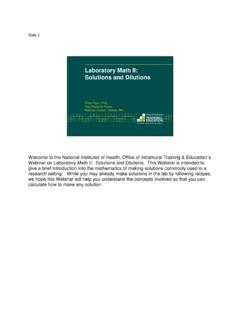Transcription of Chapter 10 Chemical Reactions - Glendale Community College
1 1 Smith, Clark (CC-BY-SA ) GCC CHM 130 Chapter 10: Chemical Reactions Chapter 10 Chemical Reactions Law of Conservation of Matter The Law of Conservation of Matter tells us that matter (or mass) cannot be created nor destroyed. This is very important in Chemical Reactions because it means that the mass of the reactants must equal the mass of the products. Or in other words, the number of reactant atoms must equal the number of products atoms. Because of this law Chemical Reactions must be balanced. What is a Chemical reaction? It is when we us formulas and symbols to describe a Chemical reaction, or reactants becoming products: A + B C + D reactants products what we start with new substance(s) formed Symbols: You must know which elements are solid, liquid, and gas!!! (s) = solid (g) = gas (l) = liquid NR = no reaction = heat (aq) = aqueous solution (ions or compounds dissolved in water) Example: H2SO4 (aq) + 2 NaHCO3 (s) Na2SO4 (aq) + 2 H2O (l) + 2 CO2 (g) Diatomic Molecules: You should know the seven elements that exist as diatomic molecules: H2(g) N2 (g) F2(g) O2(g) I2(s) Cl2(g) Br2(l) Have no fear of ice cold beer However these elements are not diatomic when they are in compounds, for example the correct formula for sodium chloride is NaCl not NaCl2.
2 These elements are only diatomic when they are alone as an element. CaCl2 has two Cl s because Ca is +2 charged so we need two 1 chlorines. Not because Cl is diatomic. Balancing Chemical Reactions Due to the Law of Conservation, the number of atoms (and the mass) of each element must be equal on both sides of the equation. In other words, you must have the same number of each type of atom on both sides of the arrow. If there are four hydrogen atoms on the left side you must have four hydrogen atoms on the right side as well. 2 Smith, Clark (CC-BY-SA ) GCC CHM 130 Chapter 10: Chemical Reactions 2 H2(g) + O2(g) 2 H2O(g) This is a balanced equation same number of H and O atoms on both sides of the arrow. To balance an equation, we adjust the coefficients these are the numbers in front of the reactant and product elements or compounds never change the subscripts.
3 A coefficient multiplies the entire formula that follows it. 2 H2O means 2 complete water molecules so 4 H atoms and 2 O atoms total are present. BALANCING SUGGESTIONS: 1) Make sure the formulas are correct if you wrote the reaction. If you put a metal and nonmetal together you must CHECK that the CHARGES add to zero charge! 2) Count the # of atoms for each element on both sides of the equation 3) Change coefficients NOT subscripts. 4) Balance polyatomic ions as a whole unit if present on both sides of the equation. 5) Save for last elements present in more than 2 formulas 6) Make sure you have smallest set of whole number coefficients possible Writing balanced Reactions from words Example: Write and balance the reaction between potassium and bromine, which forms solid potassium bromide. Answer: potassium is a solid that is not diatomic, bromine is a liquid that is diatomic, potassium bromide s correct formula is KBr because K is +1 and Br is -1 in a compound, so it is NOT KBr2.
4 You never carry a formula over from the reactant side. That is copy catting, which is wrong. So now write the reaction with the correct formula based on charges: K(s) + Br2(l) KBr(s) Now we must balance the reaction. We cannot change subscripts now, only coefficients, meaning you cannot make KBr into KBr2 because that is the wrong formula as explained above. 2 K(s) + Br2(l) 2 KBr (s) ( 2 K s on each side and 2 Br s on each side) Summary: You FIRST write a reaction with PROPER FORMULAS, once that is done you cannot change the subscripts. Then you can balance by adding coefficients. Types of Chemical Reactions There are six types of Reactions you must learn for this course. The following table gives the name of the reaction, a generic example, and any important notes about it. 3 Smith, Clark (CC-BY-SA ) GCC CHM 130 Chapter 10: Chemical Reactions Name of Rxn Generic Example (M is a metal) Note Combination A + B AB combining into one product Decomposition ABC A + B + C one reactant breaking down Combustion CxHy + O2(g) CO2(g) + H2O(g) We will only do hydrocarbon combustion Reactions .
5 Acid Base HX + MOH H2O(l) + MX You must correctly write the formula of MX based on charges of the ions. Single Replacement M + AX MX + A You must correctly write the formula of MX based on charges of the ions. Double Replacement M1X + M2Y M1Y + M2X You must correctly write the formulas of M1Y and M2X based on charges of the ions. In this class we will provide the products for combination and decomposition Reactions with either words or the formulas. However YOU must write the product formulas for combustion, acid base, single and double replacement Reactions yourself! That is what makes this Chapter so hard and probably this is the hardest Chapter of the course. Combination Reactions A + B AB Combination: Two or more reactants combine to form one product. Example: 3 H2(g) + N2(g) 2 NH3(g) Objectives: Be able to identify combination Reactions Be able to write combination Reactions from words Be able to balance combination Reactions Note: A triangle above the reaction arrow ( ) indicates that the reactants are heated to make the reaction occur.
6 Decomposition Reactions ABC A + B + C Decomposition: One reactant breaks down into two or more products. Example: H2CO3(aq) H2O(l) + CO2(g) Objectives: Be able to identify decomposition Reactions 4 Smith, Clark (CC-BY-SA ) GCC CHM 130 Chapter 10: Chemical Reactions Be able to write decomposition Reactions from words Be able to balance decomposition Reactions Combustion Reactions CxHy + O2(g) CO2(g) + H2O (g) Combustion: Hydrocarbons (compounds with only C and H atoms) burn in the presence of O2 gas to produce steam (water vapor) and carbon dioxide gas. Example: C2H4(g) + 3 O2(g) 2 CO2(g) + 2 H2O (g) Objectives: Be able to identify combustion Reactions Given a Chemical equation with any hydrocarbon and oxygen gas as reactants, predict the products for the reaction ( H2O (g) + CO2 (g) ) Balance combustion Reactions (Tip: balance oxygen last) Acid Base Neutralization Reactions HX + MOH H2O(l) + MX Water is formed in some acid base Reactions .
7 When the base is a metal hydroxide such as sodium hydroxide, NaOH, an ionic compound is also formed which is called a salt. YOU must write the proper formula based on charges for the salt. Example: HCl(aq) + NaOH(aq) H2O(l) + NaCl(aq) acid base water salt Objectives: Be able to identify acid base neutralization Reactions Be able to predict the products of the reaction based on ion charges (water + salt) Balance acid base Reactions (Tip: balance water as a separate H and OH) Single Replacement Reactions M + AX MX + A Single Replacement: A Reaction where a metal replaces a cation in an ionic compound or acid. The metal has to be more active than the cation for the reaction to occur. Thus you have to understand the activity series. Example: 3 Mg(s) + 2 FeBr3(aq) 3 MgBr2(aq) + 2 Fe(s) (Mg is more active than Fe) 5 Smith, Clark (CC-BY-SA ) GCC CHM 130 Chapter 10: Chemical Reactions Activity Series: Relative order of metal elements and hydrogen arranged by their ability to undergo reaction.
8 Li > K > Ba > Sr > Ca > Na > Mg > Al > Mn > Zn > Fe > Cd > Co > Ni > Sn > Pb > (H) > Cu > Ag > Au Note: The Activity Series will be given to you on quizzes and exams Most active (closest to Li) wants to be a cation (+ charged) in a compound with a buddy such as LiCl or LiNO3. The more active metal wants to be social and have a friend. Least active (closest to Au) wants to be alone as a neutral element with zero charge such as Au(s) or Ag(s). The least active metal is not as social so wants to be alone. Objectives: Be able to identify single-replacement Reactions Be able to predict the products of the reaction using the activity series, write the formulas based on charges of the ions Balance single replacement Reactions Steps to writing single replacement Reactions : 1. Check the Activity Series to see which metal (or H) is more active.
9 2. Most active wants to be in a compound, if it is already then there is no reaction, NR, if it is not then switch partners 3. Write the correct product formulas based on ion charges if a reaction occurs 4. Write the states for the products (s, l, g, aq) 5. Balance the equation is always last YouTube Video on Steps for Single Replacement Reactions Example: Predict the products for Zn(s) + HCl(aq) ??? 1. Check the activity series between Zn and H. Find out that Zn is more active than H. 2. Thus the Zn wants to have a friend. Note that metals bond with negatively charged nonmetals. Thus the friend will be Cl and not H because Cl is -1 charged as an ion. 3. Write the products based on charges ZnCl2 + H2 (Zn is +2 and Cl is -1 thus we need two Cl ions to go with one Zn ion) Also realize that hydrogen is diatomic when alone so it will be H2.
10 4. ZnCl2 is soluble according to solubility rules thus gets (aq) and hydrogen is a gas (g) 5. Balance the entire reaction now: Zn(s) + 2 HCl(aq) ZnCl2(aq) + H2(g) 6 Smith, Clark (CC-BY-SA ) GCC CHM 130 Chapter 10: Chemical Reactions YouTube Video on Single Replacement Reactions 1 Single Replacement Reaction 2 Single Replacement Reaction 3 Double Replacement Reactions M1X + M2Y M1Y + M2X Double Replacement Reaction: Where two metal cations switch partners. When a solid is formed, it is called a precipitation reaction. A solid product is called a precipitate. Example: Na2CO3(aq) + BaBr2(aq) 2 NaBr(aq) + BaCO3(s) Objectives: Be able to identify double-replacement/precipitation Reactions Be able to identify the precipitate in the reaction Be able to predict the products and write proper product formulas for them based on ion charges Be able to balance the reaction Redox Reactions Many single replacement, combination, decomposition and combustion Reactions are also redox Reactions .

